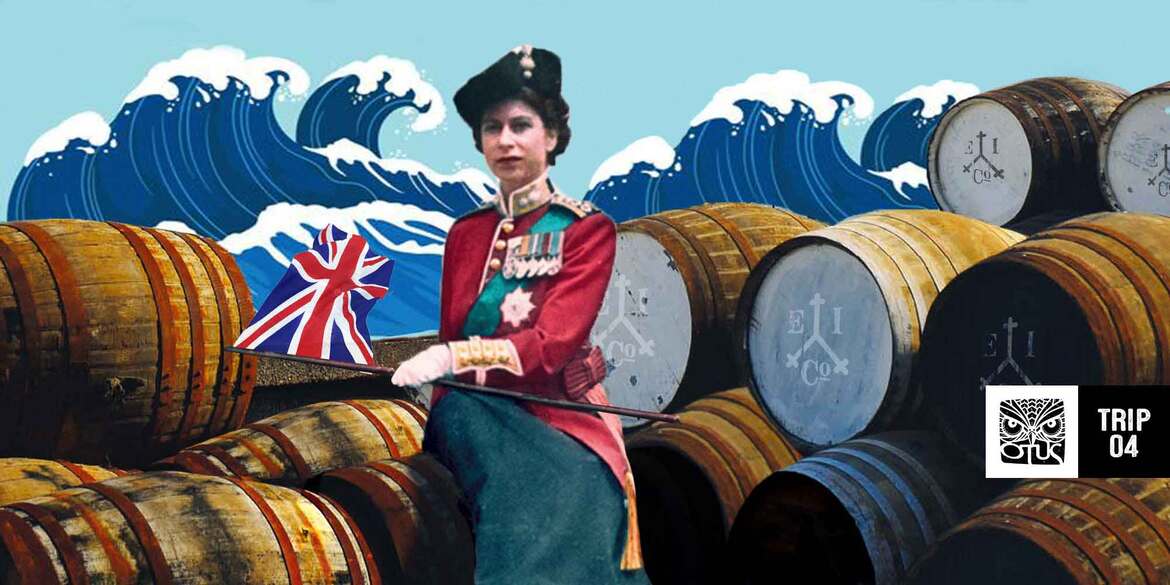
IPA, a beer created for India that is beloved by Americans
1790: British settlers in India asked for decent beers and London brewers created India Pale Ale, the hoppy style that Americans appreciate.
IPA beers were born by the creative ferment of London brewers of XIX century, that were stirred to innovate production methods by international market expansion. In this case, British settlers from Eastern colonies asked for a good beer. Follow us in this brief event reconstruction that led to the birth of IPA and its American cousin American India Pale Ale, one of the most widespread beer style nowadays.
English settlers in India asked for decent beers.
It all began when English settlers that lived in India in the mid-eighteenth century started to complain about the poor quality of beer that came in barrels from motherland circumnavigating Africa. Porter and Pale Ale from London, stowed on cargo ships with other goods to be delivered to colonies, arrived deteriorated at destination due to the difficult and never-ending journey that last almost six months. It was time that someone satisfied the desire of good beer of British troops and civilians that were exhausted by tropical and sub-tropical climates.
English brewmasters experimented new production methods and nevertheless historical records cannot trace a unique fatherhood to India Pale Ale, tradition has recognised the merit of finally solving the beer deterioration problem during long sea journeys to the London brewer George Hodgson, owner of Old Bow Brewery.
October Beer, IPA prototype is a “robust beer”.
Hodgson was a man with a sharp business acumen. Thank to a competitive price policy he gained the favours of East India Company captains and used them as sale intermediaries to conquer the Eastern market. To make the beer more long-lasting and durable to the journey, he started from Pale Ale recipe and made some changes: he used more malt and added sugar, increasing in this way the alcoholic content; moreover he considerably increased the hop quantity with the aim of taking advantage of its antiseptic and antioxidant properties. The result was a much more bitter and robust beer (10° C) known as October Beer, that finally arrived undamaged at destination.
Hudgson created an amber and hopped beer with a more bitter taste, but at the same time drinkable, perfect to be drunk also with higher temperatures.
Burton-on-Trent hard water valued hop flavour.
The East India Company lost confidence in Old Bow Brewery soon – it seemed because of a cheeky unfair competition – and turned to other breweries, among which Allsopp, Bass and Salt, all located in Burton-on-Trent, a small town in North London. If London water – rich in bicarbonate – valued Porter and Stout dark and toasted malts, the Burton wells’ one, rich in salts and sulphates, brought out bitterness coming from intense hop flavour. In 1822 the first ship with Pale Ale produced by Allsopp Brewery set sail from England, its destination was British India.
IPA style was officially born
Starting from 1830s the term India Pale Ale was coined to mark that beer produced in England expressly for Eastern British colonies. Later, in 1839, the advent of the railway in Burton improved communication and commercial transport and increased the quantity of IPAs exported to India and other British colonies, but also to the rest of Europe and to the USA.


Pale Ale 66 label appeared in Manet's painting A Bar at the Folies-Bergère.
In Burton breweries’ race to conquer the Indian market, Bass was leading and between the Nineteenth and Twentieth century it obtained international success, so much that its IPA version, Pale Ale 66, was painted in 1882 by the French pre-impressionist painter Édouard Manet in its last painting A Bar at the Folies-Bergère: on the marble counter, to the left and right of the waitress Suzon, champagne and liquor bottles are present, and a distinctive red triangle can be noticed, that marked the Pale Ale 66 bottle, that the pub was flaunting as an symbol of its international resonance.
IPA style decline at the beginning of the Twentieth century.
First World War inflicted serious harm to European economies, undermining also the blooming market of India Pale Ale. Raw material costs and production excises increased; then American Prohibition imposed massive restriction to trade and alcohol consumption. As a result, IPA progressively lost importance in favour of Lager, with a lower alcoholic content.
IPA rebirth passed on the United States.

Picardin CC BY 4.0 <https://creativecommons.org/licenses/by/4.0> via Wikimedia Commons
Until mid-twentieth century only Lager beers with a low alcoholic content could be found in America; different and refined products came exclusively as imports from Germany, Belgium, England and Ireland.
Fritz Maytag from Anchor Brewing Company of San Francisco made his contribution to US brewing industry rebirth; n 1971 he removed malt “substitutes” like corn, rice and sugar from his industrial beer recipe, so he went back to malt use (in grains instead of malt extract) and introduced new types of hops, that conferred more complex aromas.
Craft beer and homebrewing phenomena were coming: in a short time lots of micro-breweries were born, that considered IPA style as the most adequate to value the several aroma hints of US hops, imparting in this way a bitter, more rural and peculiar taste.
In the US, research on a bitter taste that was more intense and with a higher alcoholic content led to American Pale Ale, a British India Pale Ale evolution that, if compared with this one, that is more bitter and with a stronger hop flavour. American IPA is divided in different sub-styles, each one tends to highlight in its own way the citric, floral, balsamic, resin, spicy and tropical hints of American hops (think about Cascade, a famous hop with grapefruit zest aroma).

Lots of American IPA versions are produced through the dry-hopping technique to obtain beers with fresh hop aromas.
We invite you to know and taste AUSTRALE, OTUS American IPA with soft malt aromas and with tropical fruit, red berries, resin (pine needles) and herbs hints.


